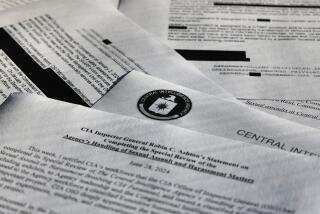CIA torture report shows shifting rationales for brutal interrogations

One of the chief points of the Senate’s report on the CIA’s torture of prisoners at its secret detention camps is that the expressed justifications for the often brutal interrogations shifted depending on circumstances. A prime example is the case of a Pakistani man named Janat Gul.
Gul was captured in June 2004, based in part on statements by a CIA informant identified in the report as Asset Y. The informant identified Gul as a facilitator for Al Qaeda who had knowledge of plans to conduct attacks in the U.S. in the weeks leading up to the 2004 elections.
Some CIA officers had doubts about Asset Y’s reliability, calling his statement “worthless” in an email that is excerpted in the report. Despite the doubts, CIA Director George J. Tenet sent a special request to National Security Advisor Condoleezza Rice asking permission to use the agency’s “enhanced interrogation” techniques on Gul, overriding a previous decision that had suspended all such interrogations for several months. The request said that interrogating Gul could yield “intelligence necessary to save American lives by disrupting the pre-election plot.”
The interrogations were authorized July 22, 2004. After several weeks of being hit, pushed into walls and doused with water, Gul had not divulged any information about a plot. Although the interrogators reported that his “overall resistance is currently judged to be minimal,” CIA headquarters directed that he be subjected to extended sleep deprivation, although CIA records indicate that order was not carried out, according to the report.
The interrogations continued through September, despite cables from the personnel at the detention site saying Gul seemed to have little information to impart. In October, the CIA began to reassess the information from its informant who then “admitted to having fabricated the information,” the report says.
Even so, the CIA continued to hold Gul, referring to him in November 2004 as “one of the highest-ranking facilitators in Pakistan.”
In December, the report says, “CIA detention site personnel wrote again that Janat Gul was ‘not the man [CIA headquarters] made him out to be.’” They described Gul as “a very simple man” who was not linked to senior Al Qaeda officials.
In April 2005, with Gul still in CIA custody, Justice Department officials asked the CIA what justification they had for his interrogation. The agency responded that Gul’s information had enabled them to determine that the informant was unreliable.
The agency did not “acknowledge that the asset’s fabricated reporting was the reason that Janat Gul was subjected to the techniques in the first place,” the report notes.
For more on politics and policy, follow @DavidLauter on Twitter.
More to Read
Sign up for Essential California
The most important California stories and recommendations in your inbox every morning.
You may occasionally receive promotional content from the Los Angeles Times.











